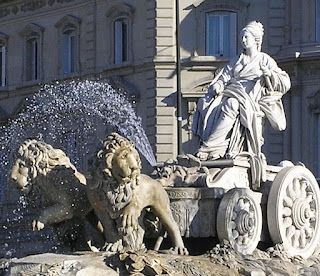Ôstara or Ēostre is the feast of the goddess Ostara, a
celebration of fertility and of her sacred marriage to the new year's Sun god.
The name Easter, the christian corruption of Ostara, is derived from it, as is
the christian "sunrise easter service" which actually honors Ostara's
aspect as a Goddess of the Dawn.
Ostara, the very essence of Spring and fertility, has been
connected to a number of female deities, such as Aphrodite, Ishtar, Freyja,
Rhea, Demeter and other Earth and Fertility Goddesses. In this photo, we see
the Goddess Cybele, who is associated with Freyja, in the Plaza de Cibeles,
Madrid. Her chariot is drawn by lions..
It seems likely that the Victorian representations of
Freyja, in a chariot drawn by cats, are meant to diminish and infantilize her.
The tales of Freyja and her chariot drawn by felines actually refer to Skogkatts
or Huldrekats; a large, lynx-like northern species of wild cat.
“Huldre”, or, “the hidden folk”, were said to be mysterious
female spirits of the forest. One imagines that lions might have been the
original creatures in some versions too, in ages long past, but certainly
domestic house cats were not intended.
Held on the Vernal Equinox, a bonfire was lit on the eve of
Ostara to mark the increase of the sun and the coming of Spring, and the ash
from the fire added to the fertility of the fields. Water drawn by the first
rays of dawn on Ostara is holy and blessed by her new- coming light.
The idea of cutting blossoming tree branches as adornments
or making Ostara trees of them, of eggs and rabbits, and of decorating eggs,
are all meant to honor her and celebrate the gift of life. These customs are of
great antiquity and are, and were, so popular that they could not be
extinguished. At the present time, they have found their true meaning again.


No comments:
Post a Comment